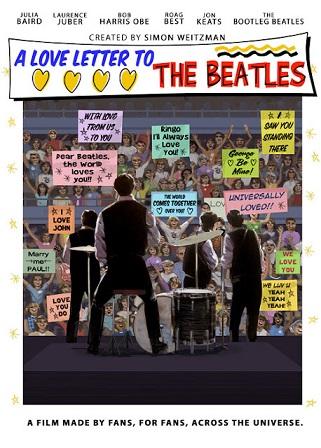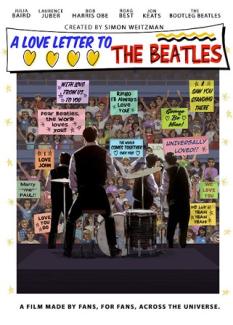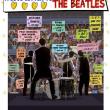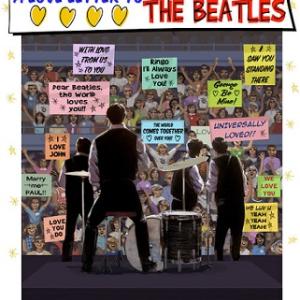Documentaries on Beatles fans, ‘Wicked’ musical
A Love Letter to The Beatles (Liverpool West Productions, Blu-ray or DVD, PG-13, 124 min.). This fan-funded documentary celebrates The Beatles' enduring legacy through the eyes of their global fanbase, including many of their cover bands. It traces The Beatles’ journey from The Quarrymen to global icons, showing how their music unites generations. It is an effective and heartfelt testament to the universal love for their music, which changed the world. There are personal stories, fan performances, rare footage and insights from those who were close to the band, including John Lennon’s sister Julia Baird and sisters Angie and Ruth McCartney.
The documentary starts with Beatles fans discussing what the group and its music mean to them. Later, we see TikTok posters using themselves to recreate scenes from “A Hard Day’s Night” and the man who, as a boy, recorded The Beatles’ performing “Paperback Writer” on “Top of the Pops” from his TV and the restoration of that otherwise lost footage.
Fascinating are the cover bands from all over the world, including The Black Ties, the all-female Dea Matrona, The Downbeat from Japan, The Bootleg Beatles, The Fab Four, Blac Rabbit duo who began busking in subway stations, The AutistiX whose members are autistic and the four REO Brothers from the Philippines. They are shown in brief performing bits, with more detailed stories and interviews given to the last three bands listed. There also is the interesting story of the Estefy Lennon Band, led by the only female John Lennon tribute performer in South America, specifically from Argentina, and her visit to London.
Also interviewed are Vivek J. Tiwary, creator of the graphic novel “The Fifth Beatle,” the story of Brian Epstein, The Beatles’ manager; and guitarist Laurence Juber, who played in Paul McCartney’s Wings band from 1978 to 1081. The film also looks at the early days of The Quarrymen, John Lennon’s original group back in 1957.
Another section interviews Mark Lapidos, who started the annual Beatles Fest in 1974, after meeting John Lennon in his Dakota apartment and getting his approval. Footage from the first Fest is included.
A nice touch is the closing with snippets strung together of different fans singing parts of “Let It Be.” Grade: film 3.75 stars
Rating guide: 5 stars = classic; 4 stars = excellent; 3 stars = good; 2 stars = fair; dog = skip it
Wicked: The Real Story (United Kingdom, Reel 2 Reel, Blu-ray or DVD, NR, 90 min.). Delve into the journey of the renowned stage production “Wicked” in this documentary, which begins with the story of L. Frank Baum, writer of the original book, “The Wonderful Wizard of Oz,” published in 1900 and first made into a stage musical in 1902. The documentary was written and directed by Robin Bextor.
Baum created the book with illustrator W.W. Denslow. The first Broadway version ran for 10 years and that show, as well as touring versions, earned Baum and Denslow more than the book, but then their partnership dissolved. Baum actually wrote 14 Oz novels before his death in 1919.
A third of the way through the documentary is a discussion of the early film versions. MGM eventually got the film rights over Walt Disney, as widow Maud Baum disliked Disney. This led to the famed 1939 musical version with Judy Garland that was one of the first major films made in color. Beginning in 1956, CBS began broadcasting “The Wizard of Oz” once a year on television.
At the 51-minute mark, the documentary finally gets to the musical “Wicked,” with extensive interviews with the novel author, Gregory Maguire, who says he realized there was no backstory for the Wicked Witch of the West, other than she had feet, and with Stephen Schwartz (also “Godspell,” “Pippin”), composer of the musical version, which recently has been made into a two-part film. Schwartz discusses the genesis of some of the songs, including playing bits on piano, and mentions homages in his “Wicked” music to Harold Arlen, composer of the music for the Garland film version. Grade: film 3.5 stars
Wicked Games: Three Films by Robert Hossein (France, 1955-1961, Radiance, 3 Blu-rays, NR, 270 min.). This box set, limited to 3,000 copies, contains films about a prison break, two femme fatales and a genre-defining Zapata Western. Robert Hossein (“Rififi”) was both behind and in front of the camera. He is one of French cinema's unsung stylists.
The three black-and-white films collected here include his directorial debut, “The Wicked Go to Hell” (1955, 93 min.), in which two inmates (Henri Vidal of “A Kiss for a Killer” and Serge Reggiani of “The Leopard”) join forces to stage a daring escape and then settle into a beach cabin with a hostage (Marina Vlady, then 17, as Eva). Then in his third film, “Nude in a White Car” (1958, 92 min.), drifter Pierre (director Hossein) is led by a night of passion into a relationship with two blonde sisters (Marina Vlady and Odile Versois of “Passport to Shame”). Finally, in “The Taste of Violence” (1961, 85 min.), South American revolutionary Perez (director Hossein) kidnaps the daughter (Giovanna Ralli of “The Mercenary”) of a dictator to negotiate a prisoner swap, helped by his two lieutenants, Chamaco (Mario Adorf of “The Italian Connection”) and Chico (Hans H. Neubert of “Der Richter von London”).
Hossein only directed 15 theatrical films and he acted in all of them.
In “The Wicked Go to Hell,” prison cellmates Rudel and Macquart are blamed for snitching on a third prisoner, who is beheaded in the opening scene. This leads both to fights in the prison yard, as well battles with each other until they get a chance to escape, an escape that turns into a bloody shootout after a quiet start. The prison half of the film also deals with Georges Bagot (Jacques Duby of “The Adultress”), who is forced to sing and dance by other inmates. Bagot then learns his actress wife plans to divorce him.
After sending their escape vehicle over a cliff, which is well done, the pair reach the beach – ocean waves are present in all three films, a familiar motif for Hossein – and barge into the isolated cabin of an artist, whose model, and probable lover, is Eva. Eva becomes their hostage and seems to play the two men against each other. The ending is quite interesting.
All three films come with new audio commentaries by critic and author Tim Lucas. In addition for this film, new featurettes are historian Lucas Balboa discussing the making of the film, including archival interview bits (14:52), and film historian Howard S. Berger discussing Hossein’s films (27:04). Grade: film and extras 3 stars
“Nude in a White Car” (also known as “Blonde in a White Car”) has an intriguing start as Pierre, out for a walk, is offered a ride by a blonde in a white convertible. After a short ride, she pulls over, takes off her coat – revealing she is nude – and has sex with Pierre, who never sees her disguised face. Pierre does get the license plate and, through a friend, discovers who the car belongs to.
The only trouble is there are two blonde sisters living in the house. One is Hélène (Versois), who eventually hires Pierre to manage her new record store; the other is Eva (Vlady playing a different Eva), who has been restricted to a wheelchair for two-plus years after contracting polio. Yet, despite Eva being in a wheelchair, Pierre, who moves into the house, comes to believe Eva may have been the mysterious driver. Meanwhile, Pierre falls in love with Hélène.
The film raises the question of whether Pierre is being played by both women, as the film has a very Alfred Hitchcock feel.
New extras include an interview with Vlady (9 min.) and a visual essay by critic Samm Deighan on the femme fatale in classic French cinema (17 min.). Grade: film 3.5 stars; extras 2.5 stars
“The Taste of Violence” is set in an unnamed South American country – although at one point it is referred to as being in Latin America. The opening shows a train loaded with soldiers entering a tunnel. It emerges in smoke and all but a handful of the soldiers are killed, the action still obscured by the smoke. As Perez takes Maria, the valuable daughter of the president, the final six soldier survivors are executed by a firing squad.
As Perez heads towards a hoped-for prisoner swap, his group is soon down to just Chico and Chamaco, with Chamaco soon telling Chico that he would rather kill Perez and sell Maria. This is after their horses are stolen and they have been reduced to walking.
Extras include an appreciation by director Alex Cox (“Repo Man,” “Walker”) (7:24); author C. Courtney Joyner discussing Zapata Westerns (26:24); and a 40-page booklet with new writing by Walter Chaw and newly translated archival writing by Lucas Balbo. Grade: film 2.5 stars; extras 3 stars
Flash Point (Hong Kong, 2007, Well Go USA, Blu-ray, R, 87 min.). Kung fu legend Donnie Yen (“Ip Man”) returns as the police force's most dangerous detective, building a case against a vicious trio of Vietnamese drug smuggling brothers. When evidence is destroyed and witnesses murdered, he takes the fight directly to his enemies, with no holds barred. While some of the gunplay seems unrealistic, the one-on-one fighting, which Yen choreographed, is both realistic and brutal. Yen incorporates a lot of Mixed Martial Arts techniques.
The film starts with Detective Ma (Yen) getting involved in a fight during a drug raid. He then is taken to task by the department as he has had at least three prior incidents resulting in injuries to suspects.
His next case involves the smuggling of $80 million in drugs by a trio of Vietnamese brothers. They are Archer (Lui Leung Wai of “To Be Number One”), Tony (Collin Chou of two “Matrix” films) and Tiger (Yu Xing of “Kung Fu Hustle,” “Ip Man”). The extensive final battle is between Ma and Tony. It is an eye-opening, impressively-shot fight sequence.
Ma is working with undercover Detective Wilson (Louis Koo of “Protégé,” “Paradox”), who drives for the Vietnamese gang. During the film, Wilson falls in love with Judy (Fan Bing Bing of “X-Men: Days of Future Past,” TV’s “The Empress of China”), but she is put in danger, along with several members of the police department, after Wilson’s police identity is discovered. Wilson also gets hit by a car in an attempt to kill him.
Other than the fights, other highlight scenes include a slow-motion explosion and a Ma chase scene that involves a lot of parkour-style jumping. The director is Yip Wai-Shun, who worked with Yen in “SPL: Kill Zone” (2005).
Extras include behind-the-scenes footage during the closing credits; four deleted scenes (3:19); a good making-of featurette (19:23); a shooting diary with Yen (5:33); the film’s premiere event (2:43); and an English language option. Grade: film 3.25 stars; extras 2.25 stars
Affinity (Well Go USA, Blu-ray, NR, 80 min.). Chilean martial arts star Marko Zaror (“John Wick: Chapter 4”) stars as Bruno, a PTSD-afflicted ex-SEAL. The film opens with a memory of his past rescue mission, during which a teammate (apparently his brother, we learn later) is killed.
Bruno now drinks a lot, but while at a bar, a woman drugs his drink and takes him to where he is robbed. He wakes up in an alley and has to battle four men, one of whom was trying to steal his pants. For some reason, Brunio gets arrested, but he is bailed out by Joe (Louis Mandylor of “Rambo: Last Blood”), his late father’s friend and his restaurant boss. Bruno’s female friend Fitch (Brooke Ence of “Wonder Woman,” “Justice League”) figures out the submissive drug used on him was “devil’s breath.”
Bruno then finds a beautiful woman on the ground outside his place. He takes her in, feeds her and soon falls in love with her. She has lost her memories, but later calls herself Athena. (Athena is the ancient Greek goddess associated with wisdom, warfare and handicraft.)
During a shootout in the market, Athena is kidnapped. The rest of the film deals with Bruno and Fitch’s efforts to find and rescue Athena. Joe soon joins them and, yes, it all gets tied in with the “devil’s breath” drug. The bad guy in the red suit is Krieger (Brahim Chab, who previously had mostly been a stunt performer). One other important character – the only one with more than a one-word name – is Dr. Kovalovski (Ego Mikitas of “Blowback”).
Zaror also was the film’s action director. Other than a couple of good fights, there really is not too much to the film. Grade: film 2.5 stars
The Last Ronin (Russia, 2024, Well Go USA, Blu-ray or DVD, NR, 119 min.). Ronin (Yuri Kolokolnikov of TV’s “Game of Thrones,” “Kraven the Hunter”) is on the hunt for his father’s killer in a world ravaged by nuclear war 100 years ago and climate change. Ronin believes everyone is out to get him, which proves true early on.
Outside the latest attempt to take him down, Ronin meets a young woman who offers to pay him if he will be her bodyguard on a trip to The Wall, where her former community is located. He says it will be a seven-day journey, but later they speed it up to three days. She is Mariya (Diana Enakaeva of “Cosmoball”).
Early in their travels, they are attacked by five members of a brutish clan. Ronin kills four and Mariya kills one, who happens to be the clan’s leader’s son. So soon, some two dozen of the clan are after them for revenge.
The movie, written and directed by Max Shishkin, is rather generic. The only unique touch is having bullets used as currency. One odd thing is having a major character talk in French, while everyone else speaks Russian. The sole extra is an available English dub. Grade: film 2.25 stars
About this blog:

My music review column, Playback, first ran in February 1972 in The Herald newspapers of Paddock Publications in Arlington Heights, IL. It moved to The Camden Herald in 1977 and to The Courier Gazette in 1978, where it was joined by my home video reviews in 1993. The columns ran on VillageSoup for awhile, but now have this new home. I worked at the Courier Gazette for 29 years, half that time as Sports Editor. Recently, I was a selectman in Owls Head for nine years.



























